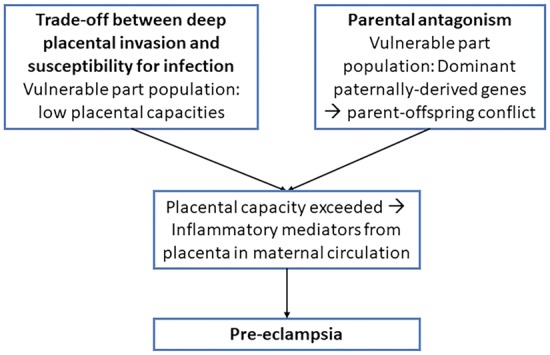Pre-eclampsia: Understanding clinical complexity.
IF 3.3
3区 医学
Q2 EVOLUTIONARY BIOLOGY
Evolution, Medicine, and Public Health
Pub Date : 2018-09-12
eCollection Date: 2018-01-01
DOI:10.1093/emph/eoy028
引用次数: 0
Abstract
Worldwide 2–8% of pregnancies are complicated by pre-eclampsia (PE), with an estimated maternal mortality of 50 000 cases annually [1]. PE is a part of the hypertensive syndrome of pregnancy and is defined as hypertension (4 140/ 90 mmHg) with proteinuria (4 300 mg/ 24 h). Symptoms of PE commence in the second half of pregnancy. These might encompass general symptoms of hypertension and/or proteinuria such as headache, exhaustion, nausea, vomiting, visual disorders and edema. Multiple organs can be affected causing severe complications such as eclampsia or progress to HELLPsyndrome. Delivery is the only definitive treatment. In preterm stages of pregnancy treatment of the disease occurs mainly symptomatically, aiming for analgesia and control of hypertension. In high-risk groups, a slight risk reduction of developing PE is achieved by administration of acetylsalycic acid in early pregnancy [2]. A century of research has not yet given physicians more powerful tools to protect both maternal and fetal conditions (Fig. 1). PATHOPHYSIOLOGY

先兆子痫:了解临床复杂性。
本文章由计算机程序翻译,如有差异,请以英文原文为准。
求助全文
约1分钟内获得全文
求助全文
来源期刊

Evolution, Medicine, and Public Health
Environmental Science-Health, Toxicology and Mutagenesis
CiteScore
5.40
自引率
2.70%
发文量
37
审稿时长
8 weeks
期刊介绍:
About the Journal
Founded by Stephen Stearns in 2013, Evolution, Medicine, and Public Health is an open access journal that publishes original, rigorous applications of evolutionary science to issues in medicine and public health. It aims to connect evolutionary biology with the health sciences to produce insights that may reduce suffering and save lives. Because evolutionary biology is a basic science that reaches across many disciplines, this journal is open to contributions on a broad range of topics.
 求助内容:
求助内容: 应助结果提醒方式:
应助结果提醒方式:


